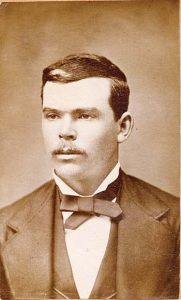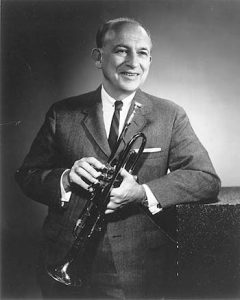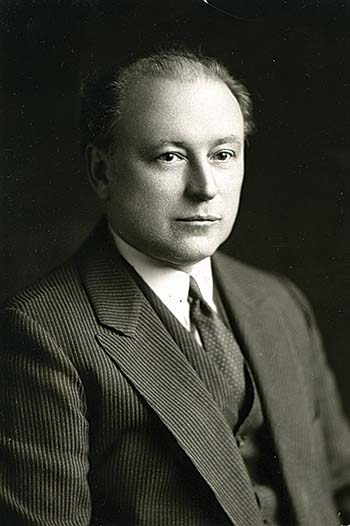
“Noted Organist Accepts Offer: Carleton Secures James R. Gillette, Nationally Known Organist.” This was the front page headline in the Northfield News of Aug. 24, 1923. When Gillette started at Carleton, he had already built up a reputation as a composer of widely used works for organ, voice, orchestra and piano. He been a recitalist at numerous organ conventions and toured as a soloist, including with the Minneapolis Symphony. At Carleton, he became chairman of the music department and developed a nationally known Carleton Symphony Band. He secured his place in musical history by writing the “Pagan Symphony,” which is considered to be the first American symphony for band.
Gillette started piano lessons at the age of six and was a church organist in Cherry Valley, New York, by the age of 10. He was a graduate of Syracuse University (1912) where he majored in organ and published his first organ composition in his senior year. After a year of graduate work there, Gillette became professor of organ at Wesleyan College at Macon, Georgia, and then he was municipal organist for Evansville, Indiana, before coming to Carleton.
According to a December 1932, cover story in a national magazine called The Bandmaster, a “small group of band enthusiasts” met with the newly appointed Gillette in November of 1923 and persuaded him to conduct the Carleton Band:
“It had been Mr. Gillette’s dream for years to lift a band from a commonplace, noise-making organization, to a position of commanding importance in the world of instrumental music.” The article said, “Band history in America was being made on that November day.” A picture of Gillette and the band was on the cover with the title, “A True Fable of Men and Instruments: The Story of the Carleton Symphony Band.”
At the end of Gillette’s first year, he directed music for the annual May Fete, which had started in 1909 and grew into a long-running extravaganza which attracted more visitors to Carleton than any other event. By 1918, it was held at Lyman Memorial Lakes. According to Northfield News stories in May of 1924, that year’s theme was “Sigurd, the Volsung,” a Viking pageant presented by 350 Carleton women:
“A gaily colored Viking ship, with red-and-white-striped hull, and glimmering blue sail embroidered in a gold design, will bring the victorious Vikings to Asgard, the home of the gods, the Valhalla of legend.” A carved dragon head adorned the prow of this “exact replica of the old Norse vessels,” with a stern in the shape of a dragon’s tail. Three oarsmen were on each side of the ship. The tale featured “old Scandinavian gods, fairies and brownies.”
This may be hard to believe, but Gillette directed a 60-piece orchestra, which was composed of not only members of the Carleton College concert orchestra, but members of both the Carleton and St. Olaf bands and 30 members of the Minneapolis Symphony Orchestra. The finale was a “Snowflake Ballet” of 125 girls dancing in “fluffy white” costumes. Despite cold, threatening weather, this 17th annual fete was presented before an estimated 4,000 people.
The next year’s theme was “The Enchanted Flute.” According to the Northfield News account of May 29, 1925, thousands of spectators were “wrapped in blankets and fur coats to ward off the chill of a cold and misty afternoon” to witness the annual May Fete. The Carleton band (which “added much to the general effect”) provided music for a story in which a disconsolate princess is accompanied by a shepherd, described as her fairy godfather in disguise. To cheer her, he plays on an enchanted flute to bring out companions for her: dancing flowers, butterflies and elves, who are frightened away by a swarm of grasshoppers. In another episode, three suitors vie for the hand of the princess and, after she turns down the two offering wealth and gifts and accepts the third one who offers love, water sprites dance in a grand finale.
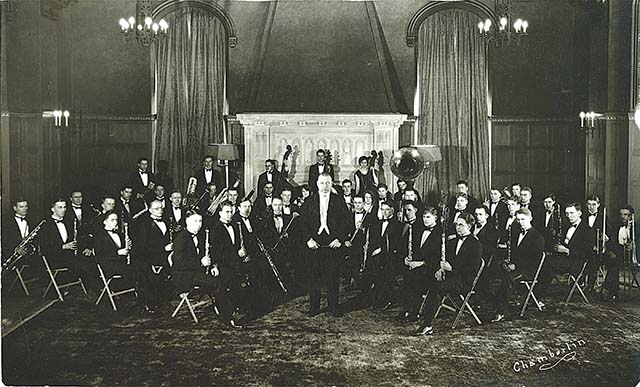
It is not known what Gillette’s opinion was of these spectacles, but certainly accompanying water sprites was not one of his musical goals.
What he wanted to do was create a symphonic band. By 1926, he had achieved his aim. Ron Rodman, current Carleton Symphony Band director, says that Gillette “conceived of the band as a sort of ‘wind orchestra’ and eschewed the band repertoire at the time, preferring to arrange and later compose music for the ensemble.” In addition to band instruments, Rodman says Gillette used “cellos, string basses, harp, bass sax (which we still have) and other instruments.”
Gillette’s vision was explained in several articles he wrote between May of 1929 and December of 1930 for School Music Magazine. Gillette felt that the real symphonic band emerges when “the conductor’s score reveals a real touch of artistry and color; when we can hear a new tonal scheme on a level with the best in orchestral fields.”
Gillette wrote, “It is the clarinet tone upon which the symphony band has its foundation…They become the violins, viola and cellos of the band, therefore carry a heavy load.” Even though a symphony band reduces the quantity of brass, he said, “it will never dispense with this most important tone.”
Of saxophones, he said: “You may kick them all around town and yet the fact remains they are capable of great effects and can be made to produce an almost solid organ-like tone. “Trombones were the “backbone material in any type of band,” creating “foundation tone,” yet he warned that “too many trombones are common in bands” and “three trombones are sufficient.” (The “76 Trombones” leading the big parade in “Music Man” fame would have been overkill, for sure.)
One of Gillette’s suggestions involved the instrument which I played in the St. Olaf Band under the direction of Miles (Mity) Johnson (an experience described in my August “Historic Happenings” column): “There has never been more than passing interest in the alto clarinet,” he wrote, and he recommended replacing it with the cello in the symphonic band. (I will try not to let this slight affect the rest of this column.)
Gillette then laid out the symphonic instrumentation at Carleton (“Some already call it ‘the Carleton Plan – and after five years of experimenting, I find no reason for making any change”): “Two flutes, one oboe, one bassoon, one sarrusophone [a metal bassoon], one E flat clarinet, 12 B flat clarinets, five saxophones (soprano, alto, tenor, baritone, bass); four trumpets, four horns, one baritone (Bass clef), three trombones, three cellos, four contra bass, one tuba, tympani, drums. At most, 45 men.” (The Carleton Symphony Band was originally all male. But by 1929, a female harpist and cellist had been added and after that, there were always women in the band.)
“Seldom in the history of instrumental music has any movement awakened greater interest than that of the symphony band,” Gillette wrote. “It is nationwide in scope, thanks to our public schools – America’s musical melting pot.” Gillette could see a resulting revolution in instrumentation, composing and conductors and a “finer type of performer.” And, for Carleton, Gillette sought out players who could fulfill his vision. As Rodman says, “He was very picky about the instrumentation of the group” and as the “ensemble grew in stature,” Gillette took the band on tours which cemented its reputation.
In 1930 the band went on tour to the west coast and Canada. One music critic wrote, “This is the greatest musical organization ever heard in Seattle!” Their concert in Winnipeg, according to the 1932 Bandmaster cover story, was a test as to “whether his ideas and ideals of band music would meet with critical public approval or would fail for lack of public interest” and “after two hours of hard playing and exacting mental discipline, youth was triumphant and Mr. Gillette’s dream of bands and band music had become a factor.”
After this concert, a Carleton band member wrote to his mother, “We played the greatest concert we had ever played and the audience went nuts…they were absolutely amazed! The soloists got 25 curtain calls, the critics were astounded…one of the greatest judges of music in Canada came running backstage and said to Mr. Gillette, ‘My God…you could go anywhere!’”
Gillette wrote a letter to President Cowling on April 3, 1930, asserting, “During the last few months, the band arrived on the level of the St. Olaf Choir and has brought to Carleton the beginning of national attention…In what might be termed an instrumental age, we have a far-reaching opportunity and a very distinct sphere of future usefulness ahead.”
At the North Central Music Supervisors Conference in Des Moines in 1931, the band played Gillette’s arrangement of Beethoven’s complete Fifth Symphony to critical acclaim and in April of 1932 performed at the National Music Supervisors Conference in Cleveland, Ohio. The latter occasion was described in the 1932 Bandmaster story:
“In back of them was the 700-piece All-Ohio Band and in front of them the vast expanse of the huge auditorium. An audience of some 10,000 was seated in the balconies. In this audience sat America’s foremost critics and musicians. Here, perhaps, was the extreme test for Mr. Gillette and the Carleton Symphony Band….There was silence. The strain of Bach’s immortal ‘Prelude, Chorale and Fugue’ floated out into the Auditorium. As some expressed it, this opening number produced in the hearers a distinct spiritual experience never to be forgotten. Again, youth had been triumphant.” (It was noted, by the way, that the band wore tuxedos, not uniforms.) The second movement of Gillette’s newly composed “Pagan Symphony” was also performed.
The eminent conductor, Edwin Franko Goldman, was present and called this concert “the greatest experience of my musical life.” Goldman was a noted composer of early 20th century marches and founded the Goldman Band in New York in 1918 (this band provided free public concerts in New York City for 93 years!).
The first complete performance of all four movements of the “Pagan Symphony” was on June 4, 1932, in Skinner Memorial Chapel. In July of 1932, Gillette was honored to be invited to direct his seminal work with the Goldman Band in New York City.
On Nov. 13, 1932, Goldman was guest conductor before a packed crowd at a concert in Skinner Memorial Chapel, having come from New York as a “friendly gesture” toward the Carleton Symphony Band. At a Homecoming chapel service the day before, as recounted in the Northfield Independent of Nov. 17, 1932, Goldman “paid high tribute” to the work of Gillette and the Carleton Symphony Band, declaring that this 70-piece band was “the best college band in the world.” The paper’s music reviewer, Dr. C.A. Mellby, wrote of the concert: “Mr. Gillette’s contention that orchestral music of the highest order can be satisfactorily adapted to and interpreted by this type of musical organization was again well proved in the classics on the program,” which included “Chorale and Fugue” by Bach and “Bolero” of Ravel. Goldman finished the program with three “unusually fine marches,” which were “played with great dash and brilliance.” Goldman premiered his latest work, a march called “The Maize and Blue,” which was dedicated to Carleton. Dr. Mellby described it as a “first-class composition, with fine melodious effects and a general Sousaesque air, which should prove extremely popular.” Goldman was “a dynamic and inspiring conductor, who made the band rise to its best possibilities.”
Gillette, who had published “The Organist Handbook” in 1926, was widely known for his Sunday afternoon organ recitals in Skinner Memorial Chapel. Before he left in 1938, he had played almost 400 recitals. (See accompanying story on Paul Morreim’s experience taking organ lessons from Gillette in 1935.)
In a Nov. 6, 1925, Northfield News story, Gillette was questioned in a feature called “Who’s Who in Northfield.” Gillette said the earliest event that he recalled in his life was watching a Fourth of July parade and that his boyhood ambition was to run a locomotive. He listed his hobby as “raising bantams” (in fact, he had exhibited Buff Cochin bantams and won with them at the New York State Fair). When asked what his advice would be to a young man about to start out in life, he said, “Choose a life work at once and stick it out to the very end.” Could the Northfield community be made better? Gillette said, “I have no criticism of Northfield community. It is a good place to live.”
A highlight of the band’s 1933 tour to Milwaukee, Chicago and Michigan was the introduction of the 1st and 4th movement of French composer Paul Fauchet’s Symphony in B-flat which Gillette had transcribed for American bands. In 1936, the number 13 was said to have “haunted this year’s band – the most capable in ‘Jimmy’ Gillette’s 13 years of directing.” According to the “Algol” yearbook, “The Carleton Symphony Band, internationally acclaimed pioneer organization, with its 56 members drawn from 13 states, 13 from Minnesota, left on its 13th annual concert tour.” The jinx “caused road-blocking blizzards, which cancelled concerts, and on Feb. 13 the accident, which was a skid into the ditch to avoid a head-on; the climax concert at Orchestra Hall, Chicago, was excellent.”
The headline of the Northfield News in Jan. 14, 1938, brought surprising news: “James R. Gillette Resigns Professorship at Carleton: Distinguished Organist and Symphony Director Ends 14-Year Service.” The story said that “Mr. Gillette will devote himself to concert and radio work…With a group of ten young musicians composing a chamber music group, he left this week on a concert tour of Eastern and southern states, the second such tour following a successful trip west last fall. Mr. Gillette directs the ensemble and plays a Hammond electric organ with it.” He was on sabbatical leave the first semester.
The Depression of the 1930s, along with the approach of World War II, led to the end of the Carleton Symphony Band of Gillette’s era.
In February of 1939, Gillette accepted a position as organist and choir director of the First Presbyterian Church of Lake Forest, Illinois, “one of the wealthy suburban churches in the Chicago area.” In July of that year, he wrote to Pres. Cowling: “My position here is full of musical adventure and I enjoy it. After musical sleeping for many years, the church wants a good program of music and is placing everything reasonable in my hands to make it possible.”
Gillette died in Lake Forest at the age of 77 on Nov. 26, 1963, following retirement in 1958. But his name lives on in musical history.
My thanks to Eric Hillemann and Carol Thunem of the Carleton Archives, Carleton Band director Ron Rodman and St. Olaf Band director Timothy Mahr for research assistance.
Paul Morreim Recalls Jimmy Gillette
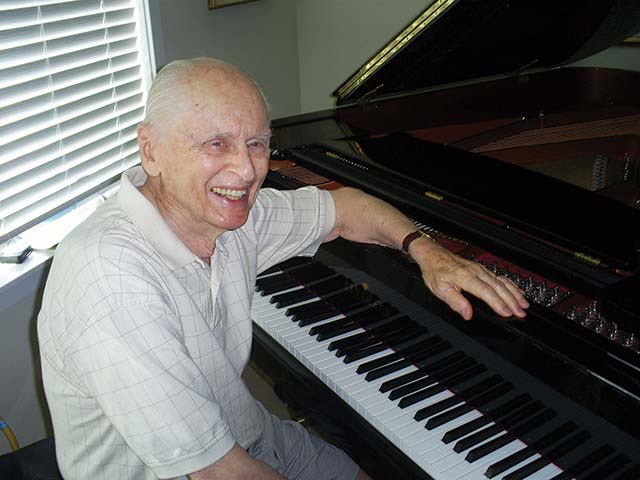
Although it happened 75 years ago, Paul Morreim (a Northfield resident) clearly remembers his association with Jimmy Gillette, who brought fame to Carleton’s Symphony Band in the late 1920s and 1930s. Morreim, a 1937 graduate of St. Olaf College, was a pre-med student but had loved and studied piano in Albert Lea since he was eight years old and had taken lessons at St. Olaf. When he received a $50 scholarship in the spring of 1935, Morreim asked himself, “Could this not be used for organ study with Gillette?” since there were no organ lessons available at St. Olaf at that time. Morreim had been walking over to Carleton to hear Gillette’s regular Sunday afternoon inspiring “Evensong” organ recitals in Skinner Memorial Chapel.
In the fall Morreim approached the St. Olaf treasurer with his idea of using his scholarship money for pipe organ study at Carleton.
“This is a most unconventional request, Mr. Morreim,” said the treasurer. “You will have to clear it with Dr. Christiansen, the head of the music department.” The meeting with Dr. Christiansen was “spirited,” said Morreim.
“I recall that you played cornet in your high school band and I should have you in my band,” said Christiansen. “Where is your cornet?” Morreim replied, “It’s home in the attic – and it’s going to stay there!” Unable to recruit Morreim for the band, Christiansen told Morreim, “Very well. You go to Carleton and take your lessons from Prof. Gillette – and give him my best regards!”
Morreim went to Carleton to check on practice rooms and could not find a time which fit his schedule. When he met Gillette in Skinner Memorial Chapel for a lesson, Morreim explained his problem and, in a relaxed fashion, Gillette said to him, “You will practice right here! Just give me an idea of your schedule and I will make sure it is available.”
So, for the first semester of 1935, Morreim took lessons with Gillette. Morreim remembers playing Bach’s Toccata and Fugue in D Minor and Mendelssohn’s Organ Sonata under Gillette’s tutelage. He describes Gillette as having a “great sense of humor, an engaging personality.” Gillette, an outgoing man, loved his students and Morreim considers that period of time when he was learning to play the organ with Gillette (though brief) “one of the highlights of my college career.”



